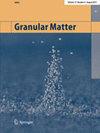DEM analysis of undrained cyclic behavior and resistance of saturated dense sand without stress reversals
Abstract
Two-dimensional discrete element method (DEM) is used to study the undrained cyclic behavior and cyclic resistance of dense granular materials under cyclic triaxial loading without stress reversals, and to clarify the effect of initial static shear on liquefaction resistance and the underlying micro-mechanism. A series of undrained stress-controlled cyclic triaxial tests were simulated with different combinations of cyclic stress ratio CSR and initial static shear stress ratio α, where the cyclic behavior of “residual deformation accumulation” was identified. Two types of residual excess pore pressure generation patterns were distinguished by the degree of stress reversal D (D = CSR/ α). The growth rate of residual axial strain is both CSR- and α -dependent. The evolution of internal structure of the granular materials was quantified using a contact-normal-based fabric tensor and mechanical coordination number MCN. The larger α (i.e., smaller consolidation stress ratios in triaxial tests) leads to higher degree of stress-induced fabric anisotropy. The cyclic resistance of dense granular materials increases with initial fabric anisotropy. During cyclic loading, the dense granular materials with higher initial fabric anisotropy exhibited slower reduction in mechanical coordination number between soil particles. The present study shed lights on the underlying mechanism that why the presence of initial static shear is beneficial to the cyclic resistance for dense granular materials under cyclic triaxial test condition.


 求助内容:
求助内容: 应助结果提醒方式:
应助结果提醒方式:


